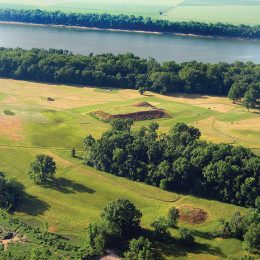
Two feast days this month make St. Joseph County a divine choice to feature.
The first is March 17 — St. Patrick’s Day.
The county on the Michigan border, of course, is home to the renowned University of Notre Dame, whose athletic teams are known as “The Fighting Irish.” The pugilistic leprechaun with raised dukes as well as shamrocks abound around the school’s famed dome of gold.
Two days later, March 19, is celebrated as the principal feast day of St. Joseph, the earthly father of Jesus Christ. The St. Joseph River flows through the county (before making its famous “south bend” back to the north) and the county.
The St. Joseph River was the area’s life blood long before Indiana statehood and the arrival of Europeans on the continent. The river was used as a major trade and migration route for the indigenous tribes that lived in the area for thousands of years. Then, it was used by French fur traders and explorers in the late 1600s.
The river, which flows into Lake Michigan north of the Indiana state line, was called “Sakiwäsipi” (outlet river) by the Native Americans in the area. Its meaning is also translated as “Coming-out River” — and is where the Miami tribe says it emerged as a distinct people.
While the father of Christ is prominent for the county and river, the famed university was named for the Blessed Virgin Mary, the mother of Jesus. In 1842, Father Edward Sorin, a French priest, founded the University of Notre Dame, located north of South Bend. Notre Dame became an intrinsic part of the area and continues to have a great effect on South Bend’s culture and economy. Saint Mary’s College and Holy Cross College are also located in the unincorporated area of Notre Dame.
Notre Dame remains a private, non-profit, Catholic-based college with about 8,600 undergraduate students and is consistently recognized among the best universities in the nation.
Aided by the success of Notre Dame’s football team in the early 1900s, Notre Dame achieved international fame and is ingrained in college football folklore. Notre Dame officially adopted the nickname “Fighting Irish” for its athletic teams in 1927. Multiple stories exist for how it received the moniker, but it’s generally believed the press coined the nickname for the never-say-die fighting spirit of the Notre Dame athletic teams.
While Irish culture surrounds the campus, St. Joseph County is home to a large population of Polish Catholic descent. Dyngus Day, a Polish feast of fun and frivolity the day after Easter, is also celebrated by the South Bend/Mishawaka communities.
The St. Joseph River continued shaping South Bend’s economy through the mid-20th century. River access assisted heavy industrial development such as the Studebaker Corporation, the Oliver Chilled Plow Company, and other large corporations. Though the Studebaker auto plant closed in the late 1950s, a national museum in South Bend pays tribute to its workers and legacy.
South Bend is also home to The Potawatomi Zoo, which opened in 1902 and is the oldest zoo in the state. In southwestern St. Joseph County, Potato Creek State Park provides abundant outdoor activities and is noted for its bicycling trails.
County Facts
Founded: 1830
Named For: St. Joseph River
Population: 270,434 (2017)
County Seat: South Bend
Noted For: University of Notre Dame, Studebaker National Museum, South Bend Chocolate Company, Potato Creek State Park



